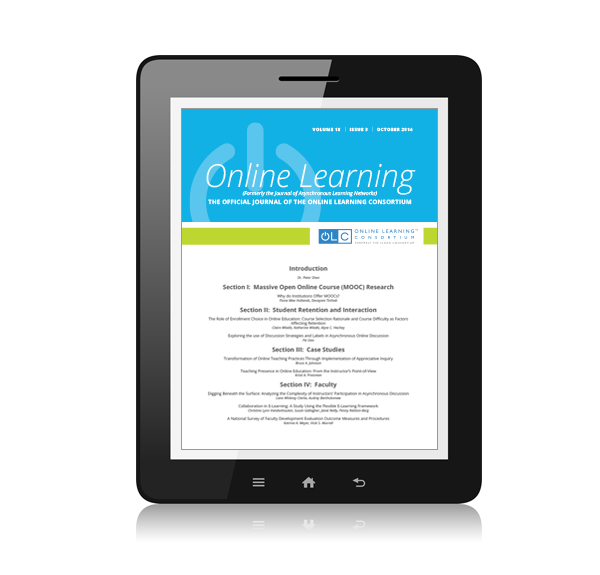Online Learning, the official journal of the Online Learning Consortium (formerly Sloan-C) promotes the development and dissemination of new knowledge at the intersection of pedagogy, emerging technology, policy, and practice in online environments. The journal has been published for nearly two decades, and is known to many by its former name, the Journal of Asynchronous Learning Networks (JALN). With the rebranding of Sloan-C to the Online Learning Consortium there has been an interest in broadening the scope of the journal. One of the areas of focus in the journal this year is the field of K12 online learning. This special issue, to be guest edited by Professors Michael Barbour and Anissa Lokey-Vega, is a step in embracing and serving the K-12 community through advancement of new scholarship in this area.
Within the past four years all 50 states and the District of Columbia have developed significant online learning opportunities for K-12 students (Watson, Murin, Vashaw, Gemin, & Rapp, 2013). K-12 online student enrollments in the US have grown from approximately 40,000 to more than four million in a period of fifteen years (Ambient Insights, 2011; Clark, 2001). Similar growth has occurred internationally, particularly in Australia, Canada, New Zealand, and several Asian nations (Barbour, 2014). While there is a developing body of research that supports the practice of K-12 online learning, most scholars agree that practice is out-pacing the availability of useful research (Cavanaugh, Barbour, & Clark, 2009; Hill, Wiley, Nelson, & Han, 2004; Rice, 2006).
The focus of this special issue of Online Learning is to present rigorous research specific to the context of K-12 education including systematic inquiry into promising practices, various schooling models, measures of quality, teacher preparation, and teacher professional development.
Examples of potential topics for this special issue include, but are not limited to, the effective design, delivery, and support of K-12 online learning; building bridges between pre-college and higher education through online education; effective models of blended learning; effective practice in supporting exceptional K-12 learners; longitudinal outcomes for K-12 online learners; studies of teacher preparation and teacher professional development practices, and emerging research methods in K-12 online or blended learning.
Submissions for this special issue are due June 30, 2015 and should be submitted via the Open Journal System for the Online Learning Consortium at http://olj.onlinelearningconsortium.org/index.php/jaln. The anticipated publication of the issue is December 1, 2015.
- To submit a manuscript please visit the Open Journal System website and create an account/log into your account. Please be sure that your profile’s “author” box is checked.
- When you have logged into your account, go to the User Home page and select [New Submission]. Please choose the Section entitled: K-12
- Authors with questions may contact Anissa Lokey-Vega (avega4@kennesaw.edu) or Michael Barbour (mkbarbour@gmail.com) about the special issue. For technical questions regarding manuscript submission contact Beth Meigs (beth.meigs@onlinelearning-c.org)
If you are interested in becoming a reviewer for this special edition of the journal, please click on the link below to register for OJS, the journal review system for Online Learning, to apply.
- Register for OJS
- Provide contact information and under “Register as”, select “Reviewer: willing to conduct peer review of submissions”. In the space provided, indicate your interest in K12 issues.
- Ambient Insight. (2011). 2011 Learning technology research taxonomy: Research methodology, buyer segmentation, product definitions, and licensing model. Monroe, WA: Author. Retrieved from http://www.ambientinsight.com/Resources/Documents/AmbientInsight_Learning_Technology_Taxonomy.pdf
- Barbour, M. K. (2014) History of K-12 online and blended instruction worldwide, in R. Ferdig and K. Kennedy (Eds.) Handbook of Research on K-12 Online and Blended Learning, (pp. 25-50). Retrieved from http://press.etc.cmu.edu/files/Handbook-Blended-Learning_Ferdig-Kennedy-etal_web.pdf
- Cavanaugh, C., Barbour, M. K., & Clark, T. (2009). Research and practice in K-12 online learning: A review of literature. International Review of Research in Open and Distance Learning, 10(1). Retrieved from http://www.irrodl.org/index.php/irrodl/article/view/607
- Clark, T. (2001). Virtual schools: Trends and issues – A study of virtual schools in the United States. San Francisco, CA: Western Regional Educational Laboratories. Retrieved from http://www.wested.org/online_pubs/virtualschools.pdf
- Hill, J. R., Wiley, D., Nelson, L. M., & Han, S. (2004). Exploring research on Internet-based learning: From infrastructure to interactions. In D. H. Jonassen (Ed.), Handbook of research on educational communications and technology (2nd ed.). Mahwah, NJ: Lawrence Erlbaum Associates, Publishers.
- Rice, K. L. (2006). A comprehensive look at distance education in the K-12 context. Journal of Research on Technology in Education, 38(4), 425-448.
- Watson, J., Murin, A., Vashaw, L., Gemin, R., Rapp, C. (2013). Keeping pace with K-12 online and blended learning: A guide to policy and practice. Evergreen, CO: Evergreen Consulting. Retrieved from http://kpk12.com/

